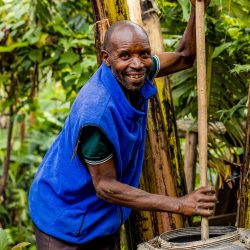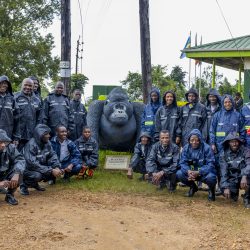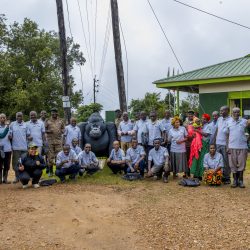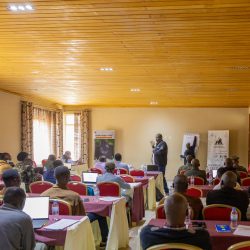Climate Change and Gorillas in a Congolese Forest
Blog | 14/10/09
The sky is rumbling overhead, like one of the creaking, overloaded trucks that ply the rutted road, like scurrying ants rushing back to their nest, which we have just left behind. No matter: I am in the forest again in the Eastern Congo, and its vivid green unfolds before me as a three-dimensional picture book bleeding off the pages. As we slip on muddy black earth ascending the first of what will be too many steep hills, I almost trample our initial sign of animal life, albeit a small one. A fat chocolate brown millipede has curled up at my feet, revealing only its protective outer shell while waiting for the danger to pass. The forest is still alive!
I am scaling the lower reaches of Mikeno, the second highest peak of the Virunga Volcano chain, today with IGCP Species Conservation Coordinator Augustin Basabose and Botanist Gratien Bashonga Muganda. We are looking at flora – Virunga National Parks’ trees and plants. As the wisps of milky white clouds briefly part for a few rays of sun to escape, I see numbers and paint marks on the trees. Augustin and his team have created a seven kilometer transect – a narrow line cut into the forest – to look at the dynamics of the forest’s growth and regeneration.
Measuring the relative growth and health of the forest will tell us if it is being affected by climate change, and the changes in the composition and availability of food for the Park’s mountain gorillas in the long term will help us in initiating more effective action in our programs and everyday work in the conservation of this magnificent species. IGCP is undertaking the first long-term study linking mountain gorilla conservation to climate change.
As the forest’s floor opens up in a gully thick with twisted vines and beautifully delicate red and pink Impatience flowers, we run into a tall leafy tree poking the muddy sky, still standing straight and strong. “Olea”, confirms Gratien, “or Indobo in the local language.” Indobo is the most targeted species for charcoal burners, and the decimating of these forests for the local illegal charcoal trade, which by some estimates is worth more than 30 million dollars a year, is the current frontier in the struggle to save the Park.
The patch of forest we traverse today suffered greatly during the recent war in this region. When I visited just six months ago, the slopes of Mikeno’s sister volcano Nyiragongo were smothered with billowing smoke from illegal charcoal kilns and a few remnant rebel camps. The main rebel leader had been captured in January, and peace amounted eggshells that could be cracked at any time. But the eggshell hardened, and peace here is now more than fragile hope. Passing Nyiringongo in the morning’s misty calm, the smoke is gone, replaced by a bright blue calm. “A National Park operation shut down many of the illegal charcoal teams,” Augustin informs me, adding that this forest benefits as well just from his transect project being here. “When poachers see the tags and paint on the trees, they usually run away. They realize there is monitoring and regular patrols.”
We speculate that with the calm, the wildlife will return. I almost step on a giant snail stretching slow as thick honey across the path as Augustin reveals that two gorilla nests were spotted higher up the mountain near the upper reaches of the transect. Parts of this section of transect are almost vertical, and we pull ourselves up grabbing onto spindly trees and exposed roots.
At the top of the hill the ecosystem changes: tall Indobo gives way to a patchwork of short squat trees and a few shrubs. One interesting aspect of this project is the changing of the flora and fauna at different elevations. Mikeno is the second highest of the Volcanoes, only a few meters short of champion Karisimbi, and Augustin says the study will also look at the changes in the different plant life that thrives at different altitudes. Will climate change push the gorillas further up the mountain? It’s one of many questions this study hopes to answer.

A giant snail crosses our path (slowly) - a small, but important indicator that Park is returning to normal
The transect’s upper reaches will have to wait though. With the rollercoaster of hills and valleys we can only do about two kilometers today, and we end up in a rocky basin that serves as a riverbed when the rains come, which for today we have lucked out: despite the ominous rumbling, they have stayed glued to our North, keeping us dry and providing a gorgeous nature-made exit road back out to the dusty human-made road that snakes to Goma and points beyond.
As we pick our way through the narrow gully, we pass a skinny vine with ordinary looking leaves thrusting itself into our path like a security gate. “Muvunja-Ukumu”, declares Gratien. I soon find out this ordinary looking plant has extraordinary powers: stuffed in the pocket, it provides protection from dangerous animals in the forest, as well as dangerous people outside the forest. “If someone means you harm”, the team tells me, “and you have this plant with you, they will not see you. You are invisible.”

Smoke billows from illegal charcoal kilns in the Park, reminding us there still much work to be done
Magic? I have learned here that nothing is beyond the realm of possibility, and as the forest closes in, I see growth and possibility in its wildness. I think to myself that perhaps Muvunja-Ukumu really has contributed to all the dedicated Park staff, conservation organizations and local people who keep destructive forces at bay. As we dodge the last prickly nettle and emerge into a neighboring farm stuffed with young sweet potato and bean plants, my thickening magic eggshell is shattered: across the road where the trees in the park’s flat Western sector seem to stretch into infinity, I see no less than four plumes of smoke curling into blue ether. Charcoal kilns. So we still have a lot more work to do. But I am heartened by the fact that there will be no shortage of fiercely dedicated people, like Augustin, Gratien and our accompanying National Park ranger team, to do it.






